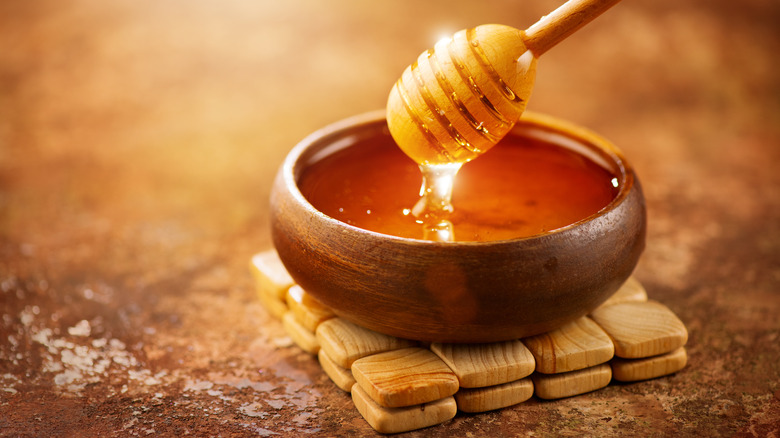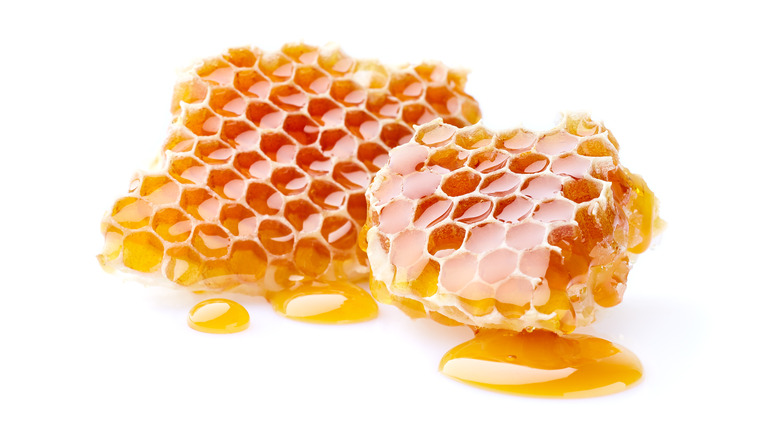Read This Before Eating 'Mad Honey'
Who doesn't love honey? From thick and creamy to thin and runny, there are literally hundreds of varieties of honey to choose from, each influenced by many different factors, including the types of flowers honey bees have pollinated and local weather conditions (via Dabur Honey). No matter what honey you chose, the ingredient can add sweetness and depth to your morning tea, afternoon toast, and evening desserts (such as baklava).
You may have heard of common honey varieties, like clover and buckwheat, but have you ever heard of "mad honey?" A potentially hallucinogenic honey that is produced by bees living predominantly in Turkey and Nepal, it contains small amounts of a naturally occurring neurotoxin called grayanotoxin (via Modern Farmer). Small amounts of this neurotoxin can lead to lightheadedness and even hallucinations.
The trade of this product dates back to at least the 1700s, when the Black Sea region exchanged the intriguing substance with Europe. And today, interest in it continues — as evidenced by the handful of "mad honey" poisoning cases that crop up, mostly in visitors to Turkey, every few years. Here's what you need to know before trying.
What makes 'mad honey' so unique?
"Mad honey" — with its potential to produce hallucinogenic effects in those who consume it — has a slightly bitter flavor and a reddish tinge (via Atlas Obscura). Why? It's due to the flowers honey bees frequent in order to produce the honey. Bees in Turkey and Nepal (the primary centers of production) visit rhododendron flowers, specifically of the Rhododendron luteum and Rhododendron ponticum varieties. These flowers contain grayanotoxin, that potent neurotoxin described above, that can produce effects ranging from temporary paralysis to true hallucinations.
The effects of consuming "mad honey" vary by dose. But although thrill-seekers continue to indulge in the honey looking for psychedelic effects, many people who eat it get sick, experiencing what's called "mad honey" poisoning (via Modern Farmer). The effects of this are wide ranging, and include vomiting, diarrhea, numbness, and fever (via Wilderness & Environmental Medicine). These effects are typically temporary and tend to resolve within a few days. However, in rare cases, as Modern Farmer noted, death has occurred.
Why eat 'mad honey?'
With the potential effects of "mad honey" ranging from gastrointestinal issues to neurological ones, why would anyone choose to eat this substance? According to Modern Farmer, the product has long been considered a traditional medicine in Turkey. Süleyman Türedi, a Turkish doctor who studies the honey's effects, told the outlet, "People believe that this honey is a kind of medicine. They use it to treat hypertension, diabetes mellitus and some different stomach diseases." He also said it can be used to improve sexual performance.
Traditionally, "mad honey" is only consumed in small amounts and often stirred into boiled milk. It should not be eaten the way we're used to eating honey, slathered across bread or stirred generously into tea. Eating the honey in these quantities is the likely explanation for modern reports of poisoning.
So, if you do get your hands on this unique treat (it can be found online for up to $166 per pound) exercise restraint. As Türedi explained, "We know that if you eat more than one spoonful of honey including grayanotoxin, you are at risk of 'mad honey' poisoning."


